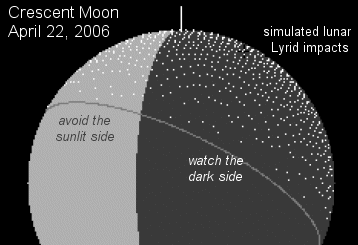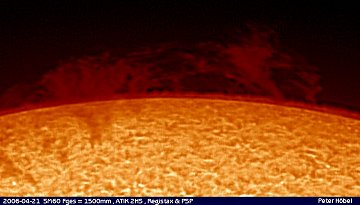 Did you sleep through the auroras of April? Next time get a wake-up call. Sign up for Spaceweather PHONE.
Did you sleep through the auroras of April? Next time get a wake-up call. Sign up for Spaceweather PHONE.
METEOR ALERT: Earth is now entering the dusty tail of Comet Thatcher (C/1861 G1), and this will cause the annual Lyrid meteor shower. Forecasters expect the shower to peak on April 22nd, producing about 10 meteors per hour--modest, but pretty. The best time to look is during the hours before dawn on Saturday morning. Go to a dark site away from city lights, if possible. [full story]
The Moon will also encounter the comet's tail on April 22nd, which raises an interesting possibility: Amateur astronomers may be able to see flashes of light on the Moon when comet debris hits the lunar surface and explodes. All that's required is a backyard telescope and lots of patience.

Simulated lunar Lyrid impacts. Image credit: Pete Gural, SAIC.
Want to try? Train your telescope on the dark side of the Moon, which rises around 3 a.m. on Saturday: sky map. Lyrids will be raining down on the northern third of the visible disk. In the eyepiece, watch for fleeting, point-like flashes. Better yet, let a video camera do the watching for you. Brian Cudnik, who coordinates amateur observations of lunar impacts for the Association of Lunar and Planetary Observers, explains how.
SUN SERPENT: A serpentine solar filament resembling the Loch Ness Monster has lifted its head over the limb of the sun today, becoming a fiery prominence:

"I took this picture using a Coronado H-alpha filter and a small refracting telescope," says Peter Hoebel of Erlangen, Germany.
Where the head leads, the body follows: The rest of the filament will snake over the solar limb this weekend. If you have a solar telescope, be sure to watch the show.
more images: from Gary Palmer of Los Angeles, California; from John Stetson of Falmouth, Maine; from Robert Arnold on the Isle of Skye, Scotland; from Peter Paice of Belfast, Northern Ireland; from Michel Hersen of Portland, Oregon;

